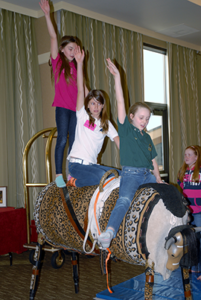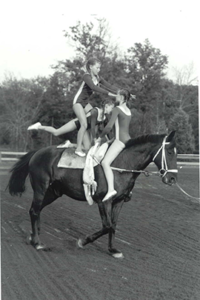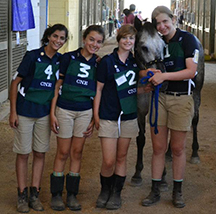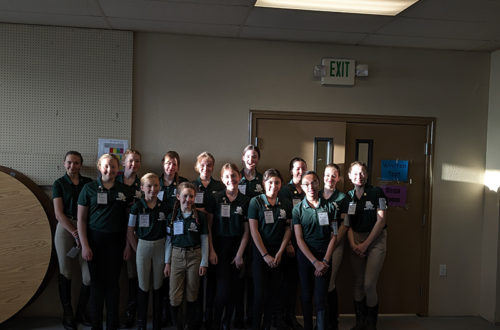The Truth About Vaulting: How to Fit a Vaulting into a Riding Program
Thanks to Sheri Benjamin and Beth Whillock, DC of Kimberwicke Pony Club and Vice RS of the Northern Lakes Region we have this handy primer to vaulting in Pony Club
When I first saw vaulting, I remember the “no way is my daughter doing THAT” moment I had as I watched two teen boys standing on the back of a huge cantering Draft horse while lifting a six-year-old girl high above their heads.
Thirteen years later I try to bear in mind that moment as I patiently explain vaulting to those unfamiliar with our sport. As we continue to bring vaulting into Pony Club, explaining vaulting, and debunking the common myths about vaulting, will become an even more frequent occurrence. This better understanding about how vaulting can benefit all riders can, in turn, encourage stables and equestrian programs across the nation to think about adding vaulting programs at their barn. But first, it is necessary to tackle the common vaulting misconceptions.
Common Vaulting Misconceptions
A conversation about vaulting sometimes starts with perceived negatives, and a sort of incredulousness that anyone would allow a loved one (or horse) to vault. Here are four common vaulting misconceptions, and the real facts that should accompany the discussion.

“Vaulting is dangerous”. As my favorite cartoon character Pepe Le Pew used to say “au contraire mon frère.” Statistically vaulting is the safest of all equestrian sports—even safer than trail riding. It is also safer than soccer, or even playing on a playground! First of all, since the lunger is controlling the horse, this allows the vaulter to concentrate on themselves and how they are interacting with the horse. The horse is chosen specifically for their calm temperament. Vaulting moves are trained on a stationary vaulting barrel before they are tried on the horse, and spotters are usually used for new vaulters and new moves. Beginning vaulting moves are usually in contact with the vaulting surcingle, so if an unanticipated dismount is required, the rider usually ends up head up and feet down.
“Vaulting horses spend their days just going around in circles, and that’s cruel”. The most amusing blog and YouTube comments posted about this “issue” are obviously written by people who are wholly unfamiliar with vaulting, and who paint vaulting as using/abusing horses worse than Annie and friends were treated at their orphanage in the eponymous Broadway show. It is NOT a “hard knock life” for vaulting horses, by any stretch of the imagination. Vaulting horses are true and spectacularly schooled athletes themselves, especially at the elite levels, and vaulting horses are cross-trained by design. Most vaulting horses have a very specific training schedule that includes everything from endurance-type trail rides to flat work in the arena to improve elasticity and quality of gaits. Some vaulting horses even jump on their non-vaulting days. A typical week for a vaulting horse would be two or three vaulting classes, two days of arena work and two days out on the trails. And when their schooling is finished they spend a good bit of time simply hanging out in pastures with their equine buddies munching on grass and watching the world go by!
“Vaulters aren’t “real” riders”. Clearly a misconception, probably thought because the lunger is seen controlling the horse during competition. Does that mean that vaulters aren’t real riders? Fact: vaulting is the original method of teaching all new riders to ride in a balanced and harmonious way. In many European countries today you must first learn to vault before you are allowed to ride solo. For safety, vaulters are first taught the important compulsory vaulting skills within their first few lessons. The first and most important of all of the compulsory moves is a balanced harmonious riding seat, which becomes the foundation of everything else a vaulter will ever learn. Vaulter-riders can perform a riding seat at a trot with no hands, and the equivalent of a Pony Club “around the world” (but with a specific count, in cadence with the horse) and what most riding clubs call an “emergency dismount”, within the first two months of lessons. Within a year or two, these same riders are usually so balanced and in harmony horse, that horse and rider can show off a stand for at least four canter strides, and then gently return to riding seat.
“Vaulters don’t have horsemanship skills”. Because the vaulting horse is controlled by a lunger from the middle of the competition circle, those who only watch vaulting performances wrongly assume that vaulters are not true equestrians and have few horsemanship skills. In fact, all vaulters, from the very beginning, are taught basic horsemanship, and it is amazing to watch a five-year old vaulter carefully approach and soothe a cross-tied horse, then calmly start picking his hooves or brushing the horse (at least the parts the vaulter can reach!). Most older vaulters are quite the avid horse lovers, and take full responsibility for the horse (either the club’s team horse, or an individual vaulting horse of their own), including riding, schooling, feeding, mucking, basic horse care, liaison with the veterinarian and farrier, etc.

How Does Vaulting Fit Into a Traditional Riding Program?
Vaulting is the ideal “gateway” entry into all things equestrian. According to Christoph Lensing (Three Time World Vaulting Cup Champion), in Germany, many beginning equestrians learn to vault before they learn to ride. Most riding centers offer vaulting programs to their youth riders because it gives new riders a feeling for the horse’s gait, better physical skills while riding (body tension and flexibility), and is a huge confidence builder. It is also a good way to have a large riding program with limited horses – it is an economical way to offer a first contact to the equestrian world. And because vaulting is commonly a team sport, it is a great way for young riders to develop social skills.
Centuries of vaulting (historically in the European and Asian military cavalry and for the last 50-plus years pre-riding in Germany) have shown that riders who learn to vault have a better riding seat, better harmony and contact with the horse, and are safer riders than those who have never been taught vaulting skills. And because the horse is controlled in the ring by an adult lunger, children can start vaulting at a much younger age than they can start riding (as early as two or three, depending on the child). The adult lunger also affords special needs children a unique opportunity to get on a horse sooner than later.
Lensing goes on to add that the transition from vaulting to riding is easily done –because the rider/vaulter already has good balance and body tension, it is easier to learn riding skills in the saddle.
That is all great but how do I learn to teach vaulting?
Pony Club currently recommends two documents that can help new coaches offer basic vaulting in their program. The first is a quick “how to offer vaulting at a mounted meeting” guide that describes how to do just that – pick a horse, find the tack, and offer vaulting at a Pony Club meeting. The second is a coach’s manual that is offered through the American Vaulting Association (AVA) about how to teach vaulting skills Training for Vaulting Coaches by Emma G Seely and Isabelle Parker. Pony Club also has a national liaison that can help you to get started; contact Beth Whillock at ewhillock@msn.com for help on how to get a vaulting program started at your club or facility.
For more information on finding a vaulting club near you, check out the AVA web page.



